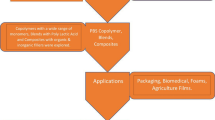Abstract
The thermal degradation behaviors of polycarbonate/polymethylphenylsilsesquioxane (FRPC) composites were investigated by thermogravimetric analysis (TGA) under isothermal conditions in nitrogen atmosphere. The isothermal kinetics equation was used to describe the thermal degradation process. The results showed that activation energy (E), in the case of isothermal degradation, was a quick increasing function of conversion (α) for polycarbonate (PC) but was a strong and decreasing function of conversion for FRPC. Under the isothermal condition, the addition of polymethylphenylsilsesquioxane (PMPSQ) retardanted the thermal degradation and enhanced the thermal stability of PC during the early and middle stages of thermal degradation. It also indicated a possible existence of a difference in nucleation, nuclei growth, and gas diffusion mechanism in the thermal degradation process between PC and FRPC. Meanwhile, the addition of PMPSQ influenced the lifetime of PC, but the composite still met the demand in manufacturing and application.
Similar content being viewed by others
References
Nishihara H, Suda Y, Sakuma T. Halogen- and phosphorus-free flame retardant PC plastic with excellent moldability and recyclability. J Fire Sci, 2003, 21: 451–464
Liu S M, Ye H, Zhou Y S, He J H, Jiang Z J, Zhao J Q, Huang X B. Study on flame-retardant mechanism of polycarbonate containing sulfonate-silsesquioxane-fluoro retardants by TGA and FT-IR. Polym Degrad Stab, 2006, 91: 1808–1814
Nodera A, Kanail T. Flame retardancy of a polycarbonate-polydimethylsiloxane block copolymer: the effect of the dimethylsiloxane block size. J Appl Polym Sci, 2006, 100: 565–575
Iji M, Serizawa S. Silicone derivatives as new flame retardants for aromatic thermoplastics used in electronic devices. Polym Adv Technol, 1998, 9: 593–600
Hayashida K, Ohtani H, Tsuge S, Nakanishi K. Flame retarding mechanism of polycarbonate containing trifunctional phenylsilicone additive studied by analytical pyrolysis techniques. Polym Bull, 2002, 48: 483–490
Zhou W J, Yang H. Flame retarding mechanism of polycarbonate containing methylphenyl-silicone. Thermochi Acta, 2007, 452: 43–48
Vyazovkin S, Wight C A. Kinetics in solids. Annu Rev Phys Chem, 1997, 48: 125–149
GamLin C, Dutta N, Choudhury N R, Kehoe D, Matisons J. Influence of ethylene-propylene ratio on the thermal degradation behavior of EPDM elastomers. Thermochim Acta, 2001, 367: 185–193
Vyazovkin S, Wight C A. Kinetics of thermal decomposition of cubic ammonium perchlorate. Chem Mater, 1999, 11: 3386–3393
Lua A C, Su J C. Isothermal and non-isothermal pyrolysis kinetics of Kapton polyimide. Polym Degrad Stab, 2006, 91: 144–153
Vyazovkin S. A unified approach to kinetic processing of nonisothermal data. Int J Chem Kinet, 1996, 28: 95–101
Saha B, Maiti A K, Ghoshal A K. Model-free method for isothermal and non-isothermal decomposition kinetics analysis of PET sample. Thermochim Acta, 2006, 444: 46–52
Paik P, Kar K K. Kinetics of thermal degradation and estimation of lifetime for polypropylene particles: effects of particle size. Polym Degrad Stab, 2008, 93: 24–35
Denardin E L G, Janissek P R, Samios D. Time-temperature dependence of the thermo-oxidative aging of polychloroprene rubber: the time-temperature-transformation (TTT) superposition method and the lifetime prediction. Thermochim Acta, 2003, 395: 159–167
Author information
Authors and Affiliations
Corresponding author
Rights and permissions
About this article
Cite this article
Wang, J., Xin, Z. Thermal degradation kinetics and lifetime estimation for polycarbonate/polymethylphenylsilsesquioxane composite. Front. Chem. Eng. China 3, 167–171 (2009). https://doi.org/10.1007/s11705-009-0006-y
Received:
Accepted:
Published:
Issue Date:
DOI: https://doi.org/10.1007/s11705-009-0006-y




